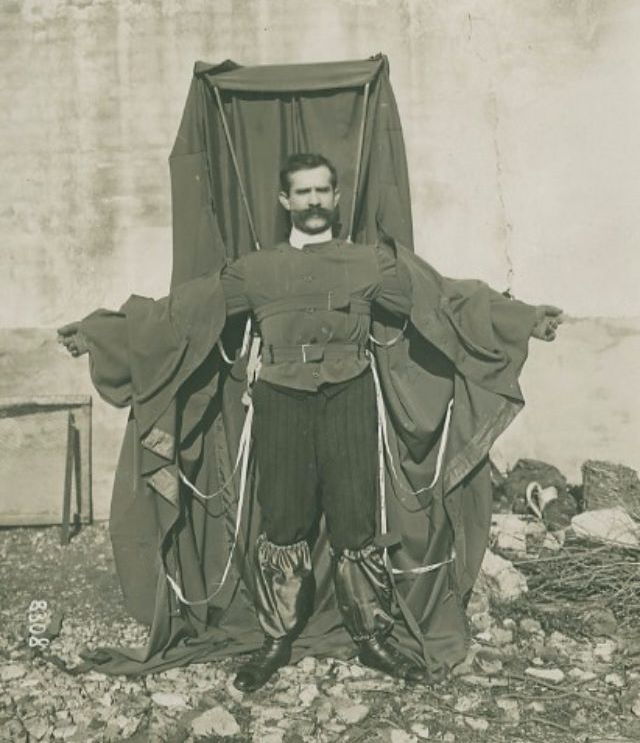On October 22, 1797, a sizeable crowd gathered at Parc Monceau in Paris to witness a daring spectacle. Frenchman André-Jacques Garnerin was set to perform a parachute jump from a hot air balloon, using a new parachute design he had created. Unlike previous designs that used a fixed wooden frame, Garnerin's parachute was made of silk and folded down like an umbrella. The umbrella-like parachute was closed before Garnerin ascended skywards riding on a basket attached to the bottom of the parachute. Once he reached a height of approximately 3,000 feet, he unfurled the parachute and severed the rope that connected his parachute to the balloon.

André-Jacques Garnerin releases the balloon and descends with the help of a parachute, 1797.
Immediately, Garnerin and his basket began to fall. The gondola swung violently during the descent, bumping on the ground and bouncing back into the air. Despite the rough landing, Garnerin emerged uninjured and triumphant, though reportedly nauseous from the oscillations. He landed about one kilometer north of the park and was quickly brought back to his starting point, where he was greeted by an enthusiastic multitude.
Among the crowd was Robert Cocking, a British watercolor artist and balloon enthusiast. Cocking was “short, round, and pleasantly untidy,” and much loved by his young students. He was obsessed with balloons, and his house was filled with his drawings of them. “He drew balloons because he loved them, and delicately stroked with the sepia over their fat sides, as a lover strokes the curls of his mistress,” wrote Charles Dickens' friend Robert Morley, who had been one of Cocking’s students as a young boy.
Parachute design was still in its nascent stage and not a lot of people had put trust on a canopy of cloth to arrest one’s fall from a high altitude. Only 16 years earlier, another Frenchman named Louis-Sébastien Lenormand had successfully demonstrated that it was possible to jump from burning buildings and land safely on the ground unhurt using an umbrella-like device to slow down one’s rate of descent. And only 15 years later, in 1912, Franz Reichelt would fall to his death while attempting to demonstrate a wearable parachute.

Franz Reichelt wearing his parachute suit.
In 1809-1810, Sir George Cayley, another pioneering aeronaut often honored by the title “the father of aviation,” wrote a paper On Aerial Navigation where he proposed that a cone-shaped parachute would provide increased stability. Cocking was convinced that with this improved design, he could imitate Garnerin’s success but with a more graceful descent.
Cocking spent many years developing his improved parachute based on Cayley's design. It was an inverted cone 107 feet in circumference. Suspended below the parachute was a wicker basket that would carry Cocking. The basket itself would be tethered to a balloon by a rope that could be severed at the right time to liberate the parachute from the balloon.
Cocking approached Charles Green and Edward Spencer, owners of the balloon Royal Nassau, to allow him an opportunity to test his invention. Despite the fact that Cocking was 61 years old, was not a professional scientist, and had no parachuting experience, the owners of the balloon agreed and advertised the event as the main attraction of a Grand Day Fête at Vauxhall Gardens.
Late in the afternoon of 24 July 1837, at Vauxhall Gardens, Robert Cocking began his ascent. Cocking was in a basket which hung below the parachute which in turn hung below the basket of the balloon, piloted by Green and Spencer. Cocking had hoped to reach 8,000 feet, but the weight of the balloon coupled with that of the parachute and the three men slowed the ascent. At 5,000 feet, Green informed Cocking that he would be unable to rise any higher as he needed all the ballast he had for their own safety in the balloon.
"Very well," said Cocking, "if you really will not take me any higher, I shall say good-bye." And with that, he pulled the latch releasing the parachute from the balloon. Relieved of the weight, the balloon shot upwards.
For a few seconds, Cocking’s parachute descended quickly but steadily and without swinging, just as he had anticipated. Then, suddenly, the entire apparatus collapsed inside out, like an inverted umbrella on a windy day. It shot straight down to the earth. When people found him in his smashed-up basket, he was still alive, mumbling unintelligibly. In ten minutes, he was dead.

The ascent of the Royal Nassau Balloon with Cocking’s parachute attached, and its fatal descent.
According to one account, after the tragedy, some unscrupulous people stole the remains of Cocking’s parachute, as well as his purse, watch, snuff box, eye glass, shoes, cap and the buttons from his coat. A local publican charged people sixpence to view Cocking’s mangled body.
Despite his untimely end and infamy as the first parachute death, many considered Cocking to be a man of science and someone who contributed to the field of aeronautics. Later analysis revealed that the parachute’s design was sound, but its construction was flimsy.
Cocking's death was a significant setback for parachute development. The tragic incident highlighted the importance of rigorous testing and the need for professional expertise in the field. Following Cocking's death parachuting became unpopular, and was confined to carnival and circus acts until the late 19th century, when developments such as the harness and breakaway chutes made it safer.
References:
# Robert Cocking, Wikipedia
# Dickens Journals Online
# Robert Cocking: Rise And Fatal Fall Of A Pioneer Parachutist, Vauxhall History


Comments
Post a Comment